Timing is everything
Synopsis : The invariant timings of brood development dictate many beekeeping events including colony inspections, queen rearing and Varroa management. It makes sense to understand and exploit these timings, rather than ignore or fight against them.
Introduction
There are some inherent contradictions involving timing in beekeeping that can confuse beginners. Actually, they can confuse anyone – beginner or old lag {{1}} – who doesn’t appreciate the considerable flexibility of some of the timings and the near-total inflexibility of others.
I think that many of the inherent difficulties in beekeeping e.g. judging when to do what to the colony, comparing seasonal differences or deciding whether intervention is needed or ill advised, are due to a lack of appreciation of the relative importance of some of these timings.
I gave an overview of some of the ‘flexible timings’ a couple of weeks ago when discussing the year to year climatic variation that compounds differences caused by latitude.
The onset of brood rearing in midwinter, the crossover date {{2}}, the start of swarming and the timings of the major and minor nectar flows can all vary from year to year.
To appreciate these you need to be observant, but predicting their impact can be tricky. Some are multi-factorial e.g. colony strength and development in a warm, dry spring can be different to a warm, wet spring.
I’ve probably written enough about some of these flexible events already so will instead focus on some of the ‘inflexible timings’ that dictate the activity of the colony and, by extension and through necessity, the activity of the beekeeper.
In many ways these are easier to understand.
By definition, they are invariable {{3}}.
Less to remember … but remembering them is important 😉
The environment
Those ‘flexible timings’ I refer to above mainly reflect the year-to-year climatic variation – warm springs, Indian summers, hard winters.
In contrast, inside the hive the environment is remarkably stable.
It can vary from 4°C to 40°C outside – even on a single day – but the temperature in the brood nest is controlled within a narrow 33-36°C range.
In fact, in the very centre of the brood nest – the region where pupal development takes place – it is as near as makes no difference 34.5°C.
The workers thermoregulate the hive, heating the comb where needed {{4}} or evaporating water to cool the hive.
With hive monitoring equipment and suitably placed thermometers you can tell when a colony shifts into brood rearing mode in the spring – the varying temperature of the clustered bees increases and stabilises to a near-invariant 34 and a bit degrees Centigrade.
The image above is from Arnia who make hive monitoring equipment. The key phrase in the sentence above is ‘suitably placed thermometers’. You tend to have only one or two and they can’t be everywhere, so it’s easy to miss the onset of brood rearing.
Temperature, behaviour and neuroanatomy
Stable temperatures are important for brood development. Worker bees reared at 32°C are less good at waggle dance communication. They only complete about 20% of the circuits (less enthusiastic) and exhibit more variability in the duration of the waggle phase (the distance component) when compared to bees reared at higher temperatures within the ‘normal’ range {{5}}.
In further studies, bees reared at abnormally low or high temperatures (though varying by only 1-2 °C from normal hive temperatures) exhibited differences in neuroanatomical development {{6}}. Of the regions of the brain studied, the numbers of microglomeruli within the mushroom bodies of the brain, areas involved in memory and learning, differed significantly when the pupation temperature was as little as 1°C over or under 34.5°C.
Despite these behavioural and developmental differences, the emergence rate and the duration {{7}} of development are somewhat less influenced by brood nest temperature.
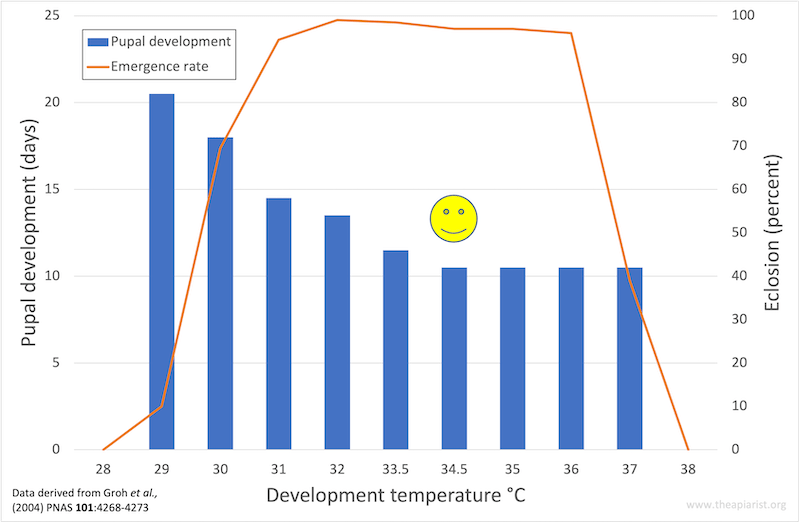
Influence of temperature on pupal brood development – duration (left axis) and emergence rate (right axis)
In the graph above the duration of pupal development is 10-11 days between 34.5°C and 37°C, and eclosion (emergence) rates exceed 90% from 31-36°C.
Correct development of honey bee workers therefore requires a stable brood nest temperature.
As a consequence of this stability the duration of the development cycle is highly reproducible and – more to the point – predictable.
Before discussing the development cycle it’s worth noting that queens and drones are reared under similarly stable conditions. I’ve discussed the influence of temperature on queen development before but am unaware of similar studies on drones.
The development of workers
The graph above shows the influence of temperature on the duration of pupal development. This is not the same as sealed brood development. {{8}}. The 10-11 days shown above needs to be extended by 2 days (48 hours) when considering the more beekeeper-friendly concept of sealed or capped brood.
Under normal conditions worker development takes 21 days. Three days as an egg, five as an open larva and 13 capped {{9}}.
During those 21 days bees go through a series of six molts between five developmental stages termed instars. The first molt is the egg hatching, molts 2-4 occur during the first few days of larval feeding. Molt 5 is the change from the pre-pupal capped larva to the pupa and the final molt occurs at emergence.
Once the brood is capped there’s nothing much the beekeeper needs to worry about (or can do). In contrast, the early days of worker development involve at least one notable event {{10}}.
Young larvae and queen rearing
The worker larva is fed progressively, which essentially means almost all the time. Nurse bees visit the larva thousands of times, initially feeding a mix of secretions from the hypopharyngeal and mandibular glands. The diet is then switched to one lacking the mandibular gland component and is finally supplemented with pollen and honey.
This dietary switch takes place around day three of larval development and effectively seals the fate of the developing bee as a worker.
Before day three of larval development, larvae destined to be workers or queens receive the same diet. After day 3 a series of genetic switches are ‘pushed’ that prevent the larva developing into a queen.
This means that larvae of less than three days old are needed to produce new queens. A terminally queenless colony will sometimes attempt to rear a new queen from an older larva (if nothing else is available) but these are usually substandard – so called scrub queens – or fail.
The adult worker
After emergence the worker fulfils a number of roles for the colony; nurse bee, comb builder, guard, scout, forager etc. The precise timings of these are flexible. Not all bees of the same age have the same role, and they can even be reversed. However, as far as practical beekeeping is concerned {{11}}, the only other timings that really matter are the longevity of workers; in the summer this is about 6 weeks and in the winter, 6 months.
The timings to remember – workers
The full development cycle takes 21 days. Larvae more than 3 days old {{12}} are unsuitable for queen rearing (and, as I shall discuss in a future post, better queens are produced from younger larvae). The adult worker spends the first half of her 6 week life within the hive, and the last 3 weeks as a forager. Winter bees live for many months.
The development of queens
The development cycle of the queen bee is shorter than that of the worker because their diet is much richer. Of course it’s not quite that straightforward (it wouldn’t be, would it?). Because of the diet there are a number of genetic pathways turned on or off in the developing queen that ensure she is ‘fit for purpose’ on emergence. The developing queen goes through the same number of molts and instars, but they are compressed in time.
The queen cell is sealed on the ninth day of development, the fifth day after hatching from the egg, and the queen emerges on the 16th day.
The adult queen
Relative to workers and drones the queen appears almost immortal. A queen may live for at least three years and, if well looked after, longer than that. Most of this aftercare is provided by the hive, but the beekeeper can influence things as well. High quality ‘breeder queens’ are often kept in nucs and discouraged from laying excessive amounts of brood. This prolongs their effective lifespan.
As far as timings are concerned – and assuming we’re not dealing with a $500 breeder queen – the only three things that are important relate to the mating of the queen.
After emergence the queen needs to reach sexual maturity before she can go on her mating flights, this takes 5-6 days. Once mated there is a further delay of 2-3 days before the queen starts laying. The final number to remember is that adult queens older than 26-33 days are too old to mate.
The timings to remember – queens
The full development cycle takes 16 days. The cell is capped on the 9th day after the egg was laid {{13}}. Upon emergence, queens take 5-6 days before they are mature enough to mate. A mated queen starts laying 2-3 days after returning from her last mating flight. If they’re not mated within about 4 weeks of emergence then they’ve blown it.
Therefore, the minimum duration to go from newly laid egg to mated, laying queen is at least 23 days. Alternatively, assuming a 2-3 day old larva is available, this time period is reduced to about 18 days.
From emergence, it’s theoretically possible {{14}} to have a mated, laying queen within 8 days.
However, in my experience, queen mating usually takes longer than these minima … and always longer than I want. Other than confirming emergence I always leave a new queen a minimum of a fortnight before checking if she’s laying, and longer if the weather has been unsuitable for mating.
The development of drones
Like teenage boys getting up late and then doing nothing other than lounge around eating and thinking about sex {{15}}, the drone takes the longest to emerge. The full development cycle from the laying of an unfertilised egg to emergence takes 24 days.
As before, the number of molts and instars are the same as undergone by queens and workers.
The adult drone
Like the queen, the drone needs to become sexually mature before going on a mating flight. This takes 10-12 days after emergence. The drone has a finite lifespan and usually lives no more than about a month during the summer.
Drones that successfully mate with a queen prematurely die. Those that don’t mate either die trying or are ejected from the hive by the workers at the end of the season.
It’s not unusual to hear beekeepers talk about finding drones overwintering. I’m not aware whether these are exceptionally long-lived drones laid by the queen the preceding summer/autumn, or laid by a failing queen during the winter, or even by laying workers in a queenless colony overwinter {{16}}.
The timings to remember – drones
The full development cycle takes 24 days. It takes about five weeks between the appearance of the first eggs in drone cells and the presence of sexually mature drones in the hive.
Swarming cannot happen until there are drones in the area, so it’s worth keeping an eye of drone brood production.
Hive inspections and queen rearing
So, there you have it, just a few numbers to remember … and, more importantly, to understand their significance for beekeeping.
Unusually I’ve prepared an oversized figure to illustrate these timings {{17}} with colour-coding worker, queen and drone events in green, blue and red respectively.
Note that some timings have dual significance. Worker larvae no more than three days old (day 6 – in green) can be reared as queens with suitable feeding.
Hive inspections … and caveats
It should now be obvious why regular weekly hive inspections are recommended in the time leading up to and during the peak swarming period.
If there are no charged queen cells – those containing eggs or developing larvae – during an inspection then any that do develop in the seven days before the next inspection will still not be sealed (and therefore the colony will not have swarmed).
This assumes that the colony swarms on or after the day that the queen cell is sealed.
Sometimes – rarely – the swarm goes early, apparently leaving only uncapped swarm cells. When I’ve had this happen a thorough examination of the brood frames has sometimes turned up a sealed cell, tucked away against a sidebar, that I’d missed in the previous inspection … the colony had not swarmed early, I’d {{18}} not been observant enough.
With a well-populated colony it’s sometimes necessary to shake all the bees off each frame to be certain there are no queen cells lurking under the ruffled curtain of workers.
Colonies containing clipped queens tend to delay swarming (but they certainly still swarm) and you can usually get away with a 10 day interval between inspections. Furthermore, since the clipped queen cannot fly, even if the colony does swarm they usually return and end up clustered underneath the OMF after she has crawled back up the leg of the hive stand.
Outside the main swarming period inspections can be much less frequent. I usually inspect only once or twice between mid-July and the end of the season.
Queen rearing
One of my (few) poorly tempered hives unexpectedly contained several 3+ day old queen cells last Sunday. I made up a nuc with the old queen, destroyed all the queen cells and closed up the hive.
They will produce more queen cells {{19}}, but they cannot swarm as there’s no queen.
At my inspection this Sunday I will destroy all the new queen cells.
The genetics of this colony are (at best) ‘undesirable’ 🙁
Since there’s been no laying queen in the hive for 7 days there cannot now be any larvae young enough to be reared as a new queen {{20}}. Therefore, having destroyed all the queen cells, I’ll add a frame of eggs and larvae from a (well-behaved and so genetically desirable) neighbouring colony {{21}}.
If they want a new queen {{22}} they will rear one from this donated frame.
The {{23}} egg in the graphic above is the earliest you can expect a laying queen. In reality – as explained above – it usually takes longer. A minimum of 30 days from egg to egg-producing queen is perhaps more dependable.
Therefore, in around 24 to 30 days – and most likely the latter – this colony will have a new queen which will hopefully improve their behaviour.
The timing of Varroa treatment(s)
But think about what’s happening to the rest of the brood in that colony.
The last eggs laid in the colony was on the Sunday the 1st of May. By the 21st of May all the worker brood will have completed development and emerged. By the 24th of May all the drones will have emerged.
The colony should therefore be broodless in the last week of May.
Even if the new queen is laying by then (some chance!) she won’t have produced any sealed brood.
If needed I could use this 7 day ’window of opportunity’ to treat the colony with oxalic acid and reduce the Varroa levels in the hive.
It’s unlikely I’ll need to as the mite numbers have been low this season. However, it’s very reassuring that I have the option should I need it {{24}}.
But … hang on a moment.
Why did I write that the colony only should be broodless?
What about the eggs and larvae on the frame I added from the donor colony? {{25}}
These will be up to one week younger than any brood in the queenless colony.
Potentially those young eggs and larvae will close that ’window of opportunity’.
Perhaps the easiest way around this is to excise one good sealed queen cell from the donated frame and leave it in queenless colony, and then remove the donated frame and use it elsewhere.
If the colony produces several good quality queen cells it’s likely that I’ll chop them all out and make up some nucs – queen rearing without all the graft.
Literally 😉
Conclusions
I’ve written far more than I intended but I think this reflects the importance of the – effectively invariant – timings of brood development.
These dictate so many of our beekeeping activities that it makes sense to learn to work with them, rather than forever struggling against them.
With good observation and regular colony inspections – weekly during the the main part of the season – there should be little or no chance of losing a swarm.
Furthermore, should a colony show signs of swarm preparation, timely intervention coupled with an appreciation of the timings of brood development, mean you have the opportunity to conduct both stock improvement and mite management.
Nice one 😉
{{1}}: Literally, ’a hardened or habitual prisoner’, but in extended use an ‘old hand’.
{{2}}: When colonies start to expand because newly emerged brood outnumbers daily worker deaths.
{{3}}: At least in the context of a functional colony in an apiary, inevitably scientists can modify some of them.
{{4}}: There are even heater bees that wedge themselves into empty cells and rapidly vibrate their thoracic muscles to generate heat – see Jurgen Tautz’s book The buzz about bees for more details.
{{5}}: Tautz et al., (2003) Behavioral performance in adult honey bees is influenced by the temperature experienced during their pupal development PNAS 100:7343-7347.
{{6}}: Groh et al., (2004) Synaptic organization in the adult honey bee brain is influenced by brood-temperature control during pupal development. PNAS 101:4268-4273.
{{7}}: You see, I finally got around to timings!
{{8}}: As I explained last week, the cell is capped for longer than pupal development takes. The open larval stage (or larvae to beekeepers!) is fed by nurse bees in the hive. The cell is then capped (referred to sometimes as the capped larval stage) and the larva is then in the pre-pupal stage which lasts about 48 hours before metamorphosis into a pupa.
{{9}}: As Maccon Keane helpfully pointed out in the comments, 3:5:13 is less easy to remember than 3:6:12 or 1:2:4, and the differences when considering brood ratios are insignificant.
{{10}}: As far as beekeeping is concerned. You can be certain that there are lots of notable events as far as development is concerned … there’s a lot of stuff going on.
{{11}}: Morphologically they are similar and there’s little the beekeeper can do to influence things, or that she needs to do in response to these various roles in the hive.
{{12}}: i.e. 6 days since the egg was laid.
{{13}}: Weather permitting, a colony intent on swarming will leave the hive with the old queen on the day the new queen cell(s) are sealed.
{{14}}: Remember that ’theoretically possible’ means ’almost never happens, and never ever happens when you need it to.
{{15}}: Actually, this is unfair to drones as they have additional roles in the hive including thermoregulation – see Kovac et al., (2009) Apidologie 40:82-95. It’s probably not unfair to teenage boys.
{{16}}: Biologically I think they are an irrelevance. It’s too early for queens and too cold for mating. It’s probably not a good sign …
{{17}}: I know the majority read this on mobiles, but – tough luck – this really needs a fold-out 27” monitor.
{{18}}: Again.
{{19}}: The queen was laying when I removed her.
{{20}}: An egg laid the minute before I removed the queen will, by Sunday, be a four day old larva.
{{21}}: I’ve yet to start queen rearing, or I’d just pop a sealed queen cell into the hive.
{{22}}: And they will … other wise they’re doomed as Private James Frazer used to say in Dad’s Army.
{{23}}: Chicken’s!
{{24}}: So much so that I’ll add a Varroa tray under the OMF in a fortnight to get an idea of the mite drop.
{{25}}: You’d forgotten those hadn’t you? … so had I in my first draft of this section!
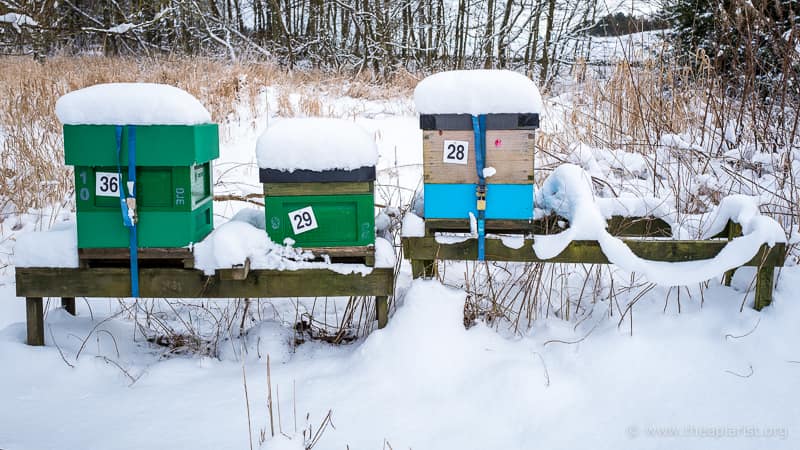
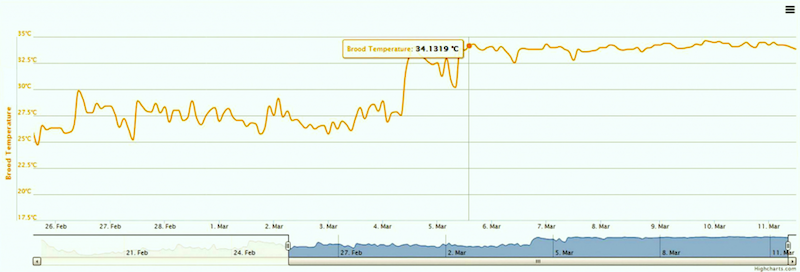
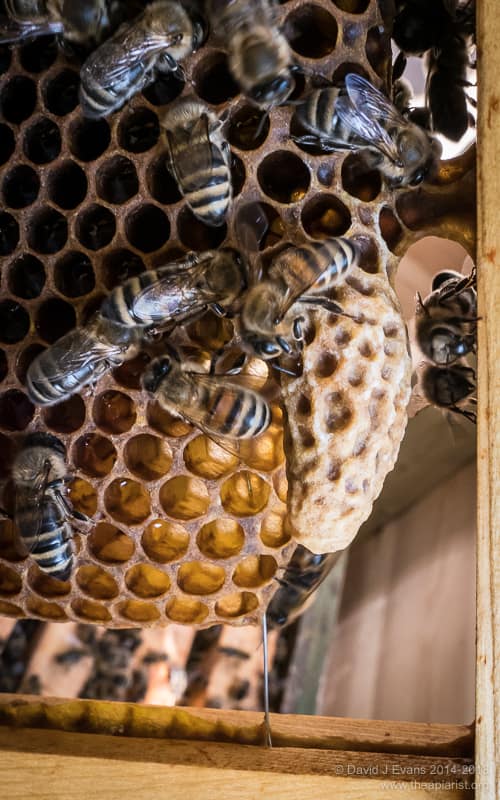

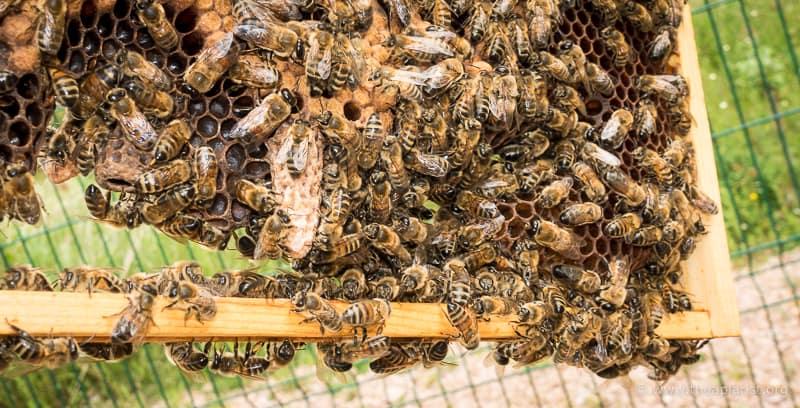
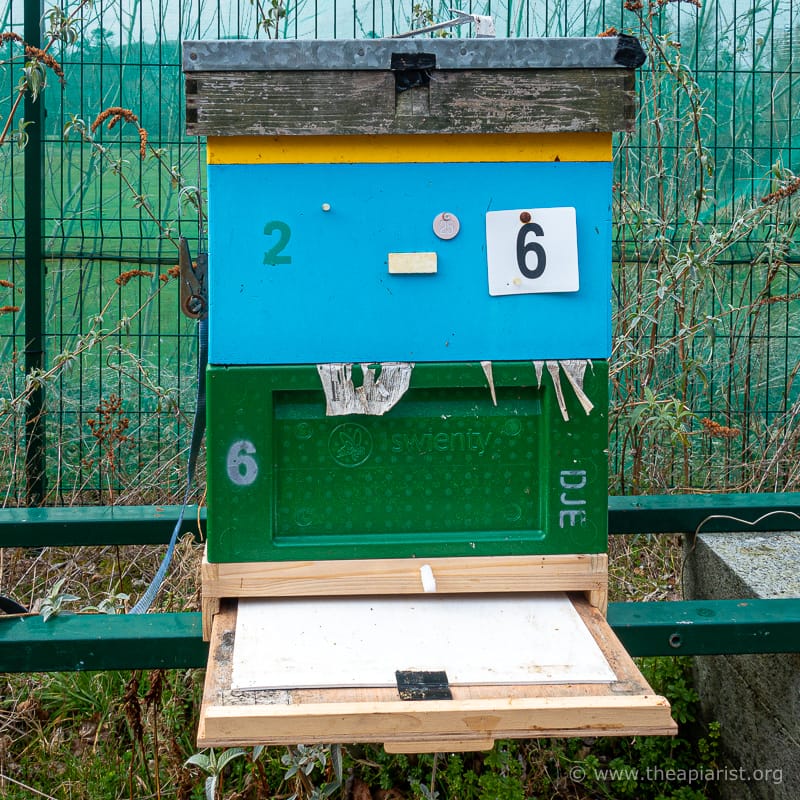
Join the discussion ...